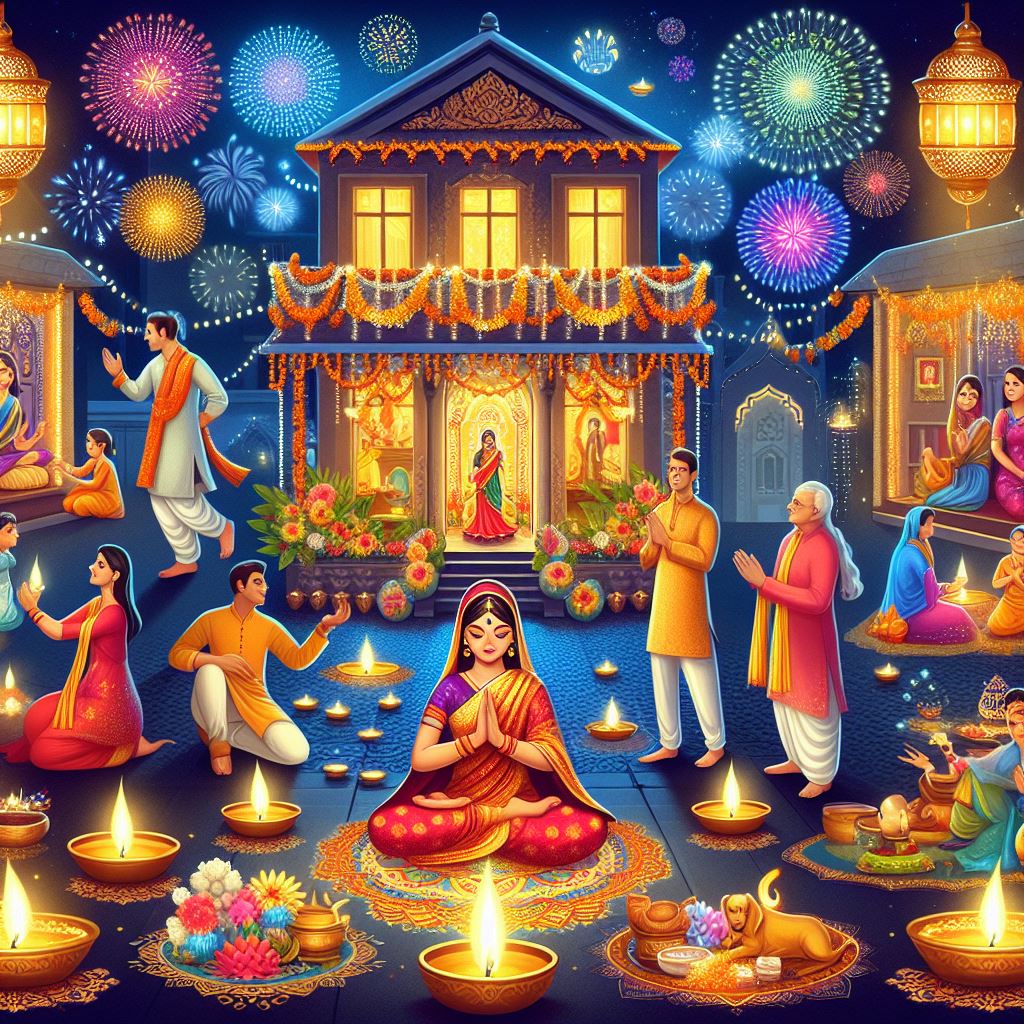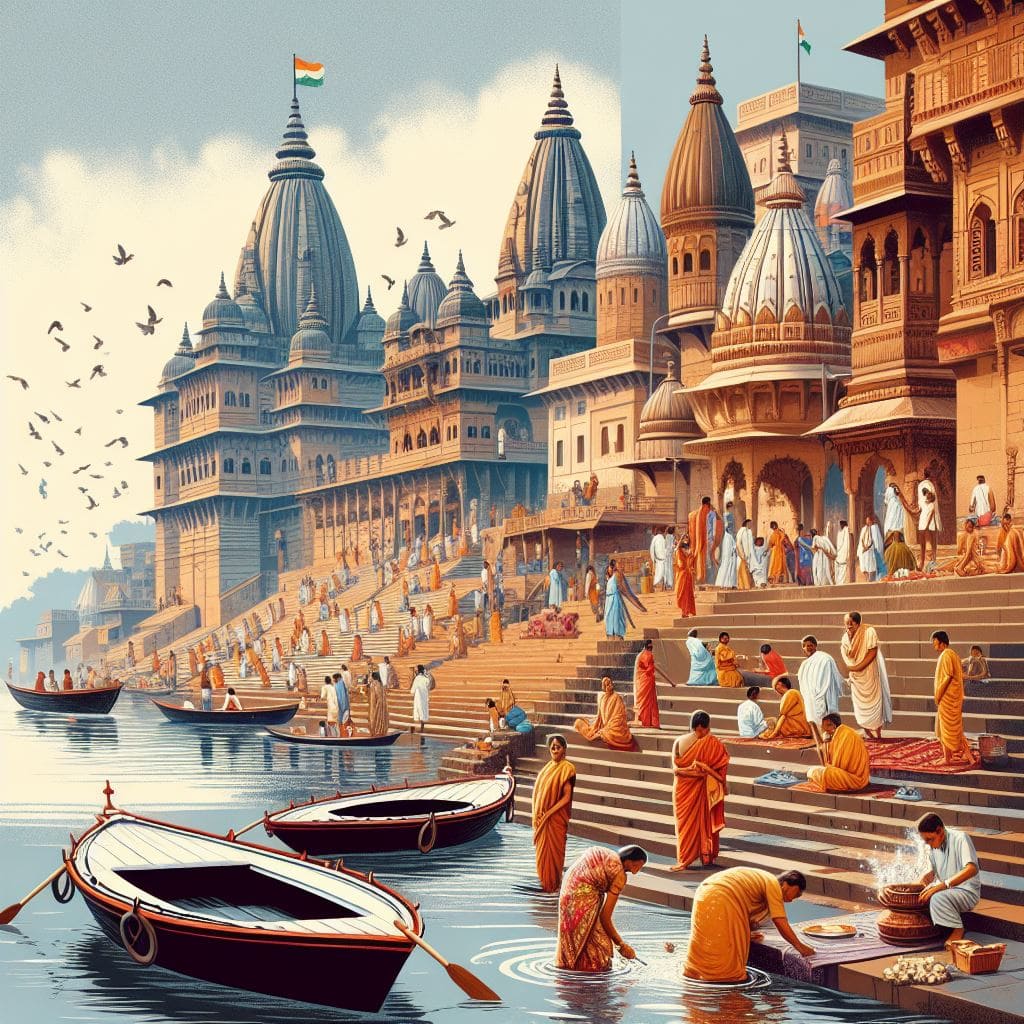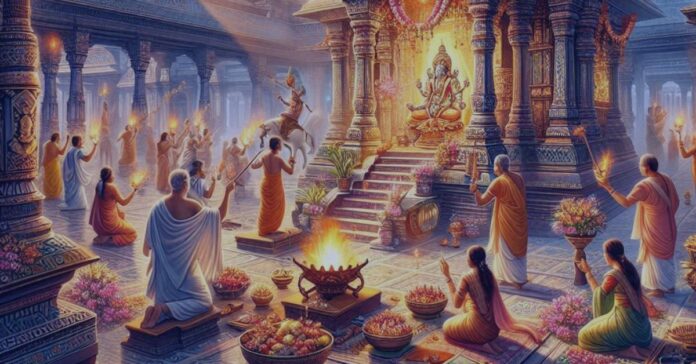Hindu culture is an ancient and vibrant tapestry that has evolved over 5,000 years, making it one of the world’s oldest living cultures. It encompasses a rich blend of festivals, traditions, rituals, and worship practices, all of which provide a profound insight into the spiritual and social life of millions of people across the globe. This blog aims to deeply explore the diverse and colorful elements of Hindu culture, delving into the significance of its festivals, the essence of its traditions, and the profound depth of its worship practices.
Festivals: Celebrations of Life and Divinity
Hindu festivals are a reflection of the religion’s deep connection with nature, mythology, and spirituality. They mark important events in the life of deities, the change of seasons, and the triumph of good over evil. Each festival is a unique blend of rituals, colors, music, dance, and food, bringing communities together in joyous celebration.

Diwali: The Festival of Lights
Diwali, perhaps the most widely celebrated Hindu festival, symbolizes the victory of light over darkness and knowledge over ignorance. This five-day festival, also known as Deepavali, is marked by lighting oil lamps, bursting fireworks, and sharing sweets. It commemorates the return of Lord Rama, Sita, and Lakshmana to Ayodhya after 14 years of exile and the defeat of the demon king Ravana. Homes are cleaned and decorated, new clothes are worn, and special prayers are offered to Goddess Lakshmi, the deity of wealth and prosperity.
Holi: The Festival of Colors
Holi, celebrated in the spring, is a festival of colors and joy. It marks the arrival of spring and the victory of good over evil, as illustrated by the story of Prahlada and Holika. The festival begins with Holika Dahan, a bonfire symbolizing the burning of evil. The next day, people take to the streets to play with vibrant colors, water, and dance to music. It’s a time to forgive and forget, to repair broken relationships, and to revel in the joy of life.
Navratri and Durga Puja: Celebrating the Divine Feminine
Navratri, a nine-night festival, celebrates the divine feminine in her various forms—Durga, Lakshmi, and Saraswati. It culminates in Dussehra, symbolizing the victory of Lord Rama over Ravana and the victory of Goddess Durga over the buffalo demon Mahishasura. In West Bengal and other parts of India, Durga Puja is celebrated with grandeur, featuring elaborate pandals (temporary structures) showcasing artistic depictions of the goddess, cultural performances, and community feasts.
Raksha Bandhan: The Bond of Protection
Raksha Bandhan is a festival that celebrates the bond between brothers and sisters. Sisters tie a rakhi (a sacred thread) around their brothers’ wrists, symbolizing their love and prayers for their brothers’ well-being. In return, brothers vow to protect their sisters and give them gifts. This festival emphasizes the importance of family bonds and the mutual responsibilities of siblings.
Ganesh Chaturthi: The Birth of the Elephant-Headed God
Ganesh Chaturthi marks the birth of Lord Ganesha, the remover of obstacles and the god of beginnings. The festival lasts for ten days, during which beautifully crafted idols of Ganesha are installed in homes and public pandals. Devotees offer prayers, sing hymns, and perform aarti (a ritual of worship with fire). On the last day, the idols are taken in a grand procession and immersed in water, symbolizing the cycle of creation and dissolution.
Traditions: The Heartbeat of Hindu Life
Hindu traditions are incredibly diverse and vary significantly across different regions and communities. These traditions are deeply rooted in ancient scriptures such as the Vedas, Upanishads, and Puranas, and are often passed down through generations. They encompass various aspects of life, including rites of passage such as birth, marriage, and death ceremonies, as well as daily rituals like worship, meditation, and prayers. Additionally, Hindu traditions also encompass a wide range of social customs, including festivals, celebrations, and specific practices related to different castes and communities.
Samskaras: Rites of Passage
Samskaras are a series of sacraments that mark significant stages in a person’s life, from birth to death. There are sixteen major samskaras, each signifying a crucial life event. Some of the most important ones include:
- Namakarana: The naming ceremony, usually held 11 to 12 days after birth, where the child’s name is formally announced.
- Upanayana: The sacred thread ceremony, marking the initiation of a young boy (and in some traditions, girls) into formal education and the study of the Vedas.
- Vivaha: The marriage ceremony, a significant social and religious event involving elaborate rituals and celebrations.
- Antyeshti: The last rites or funeral ceremonies, ensuring the soul’s proper transition to the afterlife.
Daily Rituals and Worship
Daily rituals and worship practices are integral to Hindu life. Many Hindus begin their day with a prayer or puja at home. A typical puja involves offering flowers, incense, food, and water to the deity, accompanied by the recitation of mantras. Some families have a dedicated space or room for their household shrine, which may include idols or images of various deities.
Yoga and Meditation
Yoga and meditation play integral roles in Hindu spiritual practice. Yoga, derived from the Sanskrit word “yuj,” meaning “union,” encompasses a holistic approach to physical, mental, and spiritual well-being. It involves the practice of physical postures (asanas) to promote flexibility, strength, and balance, along with breath control (pranayama) to enhance life force and meditation (dhyana) to achieve a heightened state of consciousness.
The aim of yoga is to harmonize the body, mind, and spirit, promoting overall health and well-being. Meditation, a key component of yoga, is practiced to attain mental clarity, inner peace, and spiritual awakening. Various techniques such as mindfulness, chanting mantras, and focusing on a deity or a point of light are commonly employed to deepen the meditative experience and cultivate a sense of inner tranquility and spiritual connection.
Fasting and Dietary Practices
Fasting is a common practice in Hinduism, observed during specific days of the week, festivals, or as a form of penance. It is believed to purify the body and mind, bringing the devotee closer to the divine. Dietary practices also play a crucial role, with many Hindus following a vegetarian diet out of respect for all living beings (ahimsa). Certain foods are avoided during religious observances, and meals are often prepared with great care and offered to the deities before consumption.
Worship: Connecting with the Divine
Hindu worship, known as puja, is a deeply personal and communal act that fosters a connection between the devotee and the divine. Worship can take place in temples, at home, or in natural settings. It involves various rituals, offerings, and devotional practices that honor the deities and seek their blessings.
Temples: Abodes of the Divine
Temples are considered the abodes of the divine, where the presence of the deity is believed to be more accessible. They are architectural marvels, often adorned with intricate carvings and sculptures depicting various deities, mythological stories, and symbols. Temples serve as centers of spiritual learning, cultural activities, and community gatherings.
The inner sanctum (garbhagriha) houses the main deity, and only the priest (pujari) is allowed to enter this sacred space. Devotees offer prayers, perform aarti, and make offerings such as flowers, fruits, and sweets. Festivals and special occasions draw large crowds, with elaborate rituals and processions.
Bhakti: Devotional Worship
Bhakti, or devotional worship, is a central aspect of Hindu practice. It involves expressing love and devotion to a personal deity through various forms such as singing hymns (bhajans), chanting mantras, and performing aarti. Bhakti can be practiced individually or in groups, and it transcends social and caste boundaries.
Yajna and Homa: Fire Sacrifices
Yajna and homa are ancient Vedic rituals involving the offering of ghee, grains, and other substances into a sacred fire. These fire sacrifices are performed to invoke the blessings of deities, purify the environment, and ensure prosperity. The rituals are conducted by priests, accompanied by the chanting of Vedic mantras. They are often performed during important life events, festivals, and auspicious occasions.
Pilgrimage: A Journey of Faith

Pilgrimage is a significant aspect of Hindu worship, involving travel to sacred sites associated with deities, saints, or important events in Hindu mythology. Some of the most revered pilgrimage destinations include:
- Varanasi: The city of Lord Shiva, situated on the banks of the Ganges, is one of the holiest cities in Hinduism.
- Tirupati: Home to the Tirumala Venkateswara Temple, one of the richest and most visited temples in the world.
- Rishikesh and Haridwar: Sacred cities along the Ganges, known for their ashrams, yoga centers, and the Kumbh Mela festival.
- Jagannath Puri: Famous for the Jagannath Temple and the annual Rath Yatra (chariot festival).
Pilgrimage is seen as a means of spiritual purification, penance, and the fulfillment of vows.
The Essence of Hindu Culture
Hindu culture, with its profound spirituality and rich traditions, offers a holistic approach to life. It emphasizes the interconnectedness of all beings, the importance of righteousness (dharma), and the pursuit of spiritual knowledge (jnana) and liberation (moksha). The culture is not monolithic but a vibrant mosaic of diverse practices and beliefs that have evolved over millennia.
Unity in Diversity
One of the most remarkable aspects of Hindu culture is its ability to embrace diversity. Despite regional, linguistic, and cultural differences, there is a shared reverence for the divine and a common pursuit of spiritual goals. Festivals like Diwali and Holi are celebrated with equal fervor across different parts of India, and traditional practices such as yoga and meditation have gained global recognition.
Adaptability and Continuity
Hindu culture has shown remarkable adaptability over the centuries, incorporating new ideas and influences while retaining its core values.
This dynamic nature has allowed it to thrive and remain relevant in a rapidly changing world. The continuity of traditions, passed down through generations, ensures that the cultural heritage remains alive and vibrant.
The Role of Mythology
Mythology plays a crucial role in Hindu culture, providing a rich source of stories that convey moral and spiritual lessons. The epics—Ramayana and Mahabharata—along with the Puranas, are treasure troves of narratives that illustrate the principles of dharma, the complexities of human nature, and the triumph of good over evil. These stories are not just ancient tales but living traditions that continue to inspire and guide people in their daily lives.
The Pursuit of Spiritual Goals
At the heart of Hindu culture is the pursuit of four primary goals of human life, known as the Purusharthas:
- Dharma: Righteousness, duty, and ethical living.
- Artha: Wealth and prosperity, achieved through honest and lawful means.
- Kama: Pleasure and enjoyment, within the bounds of dharma.
- Moksha: Liberation from the cycle of birth and death, the ultimate spiritual goal.
These goals provide a balanced framework for leading a fulfilling and meaningful life, integrating material, emotional, and spiritual well-being.
The Global Influence
Hindu culture has transcended geographical boundaries, influencing art, literature, philosophy, and spirituality worldwide. Practices such as yoga, meditation, and Ayurveda have gained global popularity, offering holistic approaches to health and well-being. The principles of non-violence (ahimsa) and respect for all life have inspired global movements for peace and environmental conservation.
Conclusion
Exploring Hindu culture is an enriching journey into a world of profound spirituality, vibrant festivals, rich traditions, and deep-rooted worship practices. It is a culture that celebrates the diversity of life, the unity of all beings, and the eternal quest for truth and liberation. Through the joyous celebrations of Diwali, the festival of lights, and Holi, the festival of colors, Hindu culture brings communities together to embrace joy, love, and the triumph of good over evil. These festivals are marked by lively music, dance, and traditional rituals, creating a vibrant tapestry of cultural expression.
The timeless wisdom of the Bhagavad Gita, one of Hinduism’s most sacred texts, provides a profound philosophical and spiritual understanding of life’s purpose, duty, and the nature of reality. It offers guidance on how to navigate life’s challenges and live with integrity, compassion, and devotion.
Furthermore, the serene practices of yoga and meditation are integral parts of Hindu culture, offering pathways to inner peace, harmony, and self-discovery. These practices emphasize the unity of mind, body, and spirit, fostering holistic well-being and a deeper understanding of the interconnectedness of all life.
In delving into Hindu culture, one discovers not just a religion but a way of life that embraces the sacredness of existence, the interconnectedness of all creation, and the boundless potential of the human spirit.








